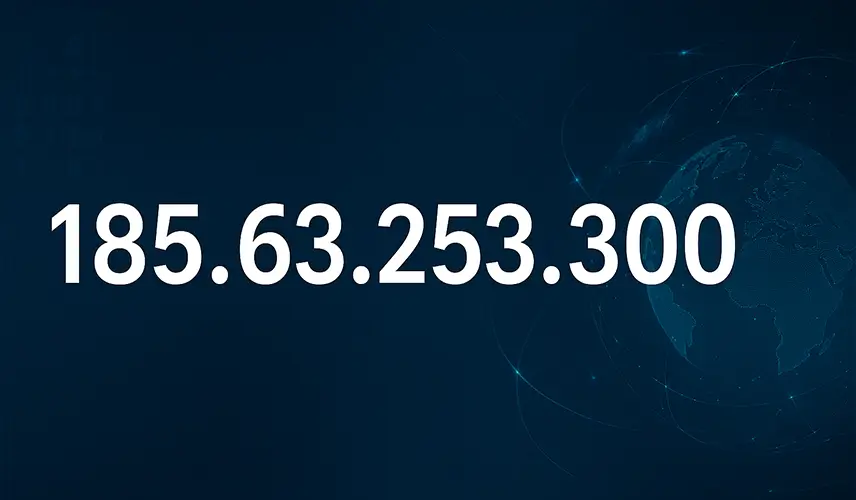Imagine you’re trying to configure your network, and you come across the IP address 185.63.253.300.
At first glance, it looks like a standard IPv4 address. But something’s wrong. It simply doesn’t work. Why?
This guide will help you understand why 185.63.253.300 is invalid, what makes an IP address valid, and what this teaches us about how the internet functions.
You’re in the right place if you’re new to networking or just curious about how IP addresses work.
What Is an IP Address?
An IP address (Internet Protocol address) is like a street address for your device on the Internet.
It allows data to be routed to the correct destination.
Types of IP Addresses:
| Type | Format | Max Addresses | Example |
|---|---|---|---|
| IPv4 | 4 sets of numbers (0–255), separated by dots | ~4.3 billion | 192.168.0.1 |
| IPv6 | 8 groups of hexadecimal numbers | ~340 undecillion | 2001:0db8:85a3::8a2e:0370:7334 |
Understanding IPv4 Format
Each IPv4 address looks like A.B.C.D, where each segment is a number between 0 and 255.
This is because each segment (called an octet) is made of 8 bits, and the maximum value for 8 bits is 255.
Why 185.63.253.300 Is Invalid
| Octet | Value | Valid? | Reason |
|---|---|---|---|
| 1st | 185 | ✅ | Within 0–255 |
| 2nd | 63 | ✅ | Within 0–255 |
| 3rd | 253 | ✅ | Within 0–255 |
| 4th | 300 | ❌ | Exceeds 255 limit |
The IP address 185.63.253.300 is invalid because the last octet exceeds the maximum allowable value of 255.
In IPv4 addressing, each octet must be within the 0–255 range.
Therefore, any IP address with an octet outside this range does not conform to the IPv4 standard and is considered invalid.
What Happens If You Use an Invalid IP?
- ❌ Cannot connect to the network or the internet
- ❌ Fails DNS resolution
- ❌ Not recognized by routers or devices
- 🚫 Blocked or ignored by software and firewalls
Common Reasons for Invalid IPs
| Cause | Description |
|---|---|
| Typo | Someone manually typed the wrong value (e.g., 300 instead of 100). |
| Fake IPs | Hackers might use invalid IPs to confuse systems or avoid tracking. |
| Placeholder Values | Used temporarily in development or testing environments. |
| Misconfigured Systems | Bugs in software or routers might assign invalid IPs. |
Implications of 185.63.253.300 IP Address
While an invalid IP address like 185.63.253.300 cannot be assigned to any device or used for legitimate communication, its presence can have several implications:
- Network Confusion: Systems encountering invalid IP addresses may experience errors or unexpected behavior.
- Security Concerns: Repeated appearances of invalid IP addresses in logs could indicate scanning attempts or other malicious activities.
- Diagnostic Challenges: Troubleshooting network issues becomes more complex when invalid IP addresses are involved.
Read also: Zryly.com Cybersecurity: A Multi-Layered Shield for Modern Threats
How to Validate an IP Address
✅ Manual Check: Ensure each number is between 0 and 255.
✅ Online Tools: Use tools like IPVoid or MXToolbox.
Code Example (Python)
import ipaddress
try:
ip = ipaddress.ip_address('185.63.253.300')
print("Valid IP")
except ValueError:
print("Invalid IP")What This Teaches Us About the Internet
- IP addresses follow strict rules.
- Even one incorrect digit can break communication.
- Validating inputs is crucial for security and reliability.
IPv6: The Future of Addressing
| Feature | IPv4 | IPv6 |
|---|---|---|
| Max addresses | ~4.3 billion | ~340 undecillion |
| Format | Dotted decimal | Hexadecimal |
| Launch Year | 1981 | 1998 |
Best Practices to Avoid Invalid IP Issues Like 185.63.253.300
- Use DHCP to assign IPs automatically.
- Validate IPs in all forms and config files.
- Monitor logs for suspicious addresses.
- Avoid manual typing whenever possible.
Conclusion
The IP address 185.63.253.300 is more than just an invalid number.
It’s a reminder of how precision, standards, and attention to detail keep the digital world functioning smoothly.
Whether you’re a beginner or IT professional, understanding IPs is essential for working with the internet today—and tomorrow.


